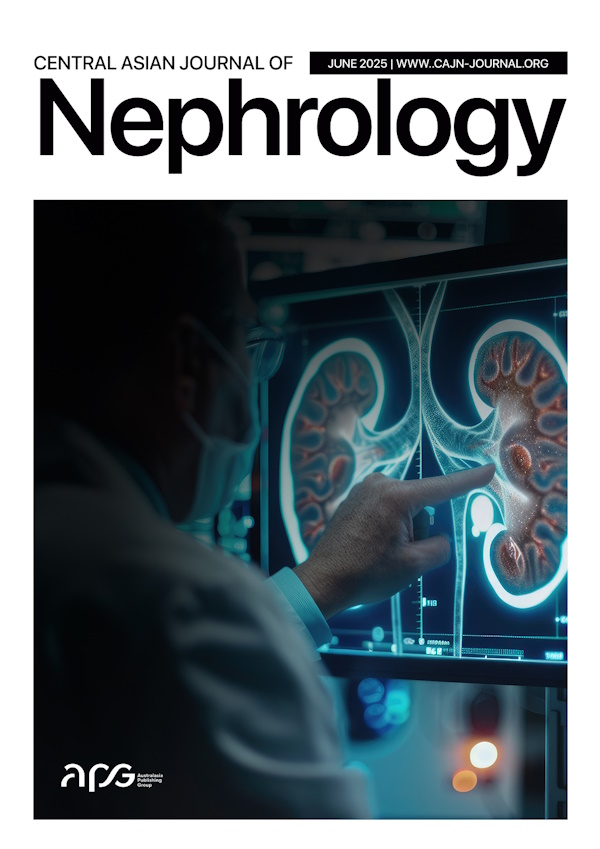
The Central Asian Journal of Nephrology (ISSN 3105-4145) aims to provide a platform for the dissemination of high-quality research, clinical studies and expert opinions in the field of nephrology. It is dedicated to improving the understanding, prevention, diagnosis and treatment of kidney diseases in Central Asia and beyond. The journal aims to promote collaboration between researchers, clinicians and healthcare professionals to address the unique challenges in nephrology faced by the Central Asian region, because of its same cultural and environment factors, genetic background and similar healthcare models.
Call for Publications
The Central Asian Journal of Nephrology invites researchers from all over the world, clinicians, healthcare professionals, and policymakers to submit manuscripts that contribute to advancing knowledge and practice in nephrology, accommodating its regional focus and the specialized field of nephrology, while ensuring relevance to both local and international audiences.
We welcome original research, reviews, case reports, and methodological papers that explore all aspects of kidney health and disease. Topics of interest include, but are not limited to:
- Prevention, diagnosis, and management of acute and chronic kidney diseases
- Dialysis and renal transplantation
- Basic science research in nephrology
- Epidemiological studies on kidney disease burden
- Public health and policy innovations in nephrology
- Applications of data science, digital health, and AI in nephrology
- Real-world evidence, patient-centered outcomes, and healthcare equity
The journal seeks to disseminate high-quality, interdisciplinary research that enhances clinical practice, informs policy, and promotes kidney health across Central Asia and beyond.
We encourage submissions that reflect regional insights, cross-national collaborations, and innovative approaches to addressing the growing challenges of kidney diseases.
Submit your manuscript today and join us in shaping the future of nephrology in Central Asia and beyond.
CURRENT ISSUE
Volume 1, Issue 2, 2025
(Ongoing)
Methods: In March 2024, 636 adults were screened through convenience sampling at four major institutions in Astana. After excluding incomplete data, 569 participants were analyzed. Demographic, lifestyle, and clinical information were collected, and serum creatinine was used to estimate glomerular filtration rate (eGFR). Reduced renal function was defined as eGFR <90 mL/min/1.73 m². Group comparisons and logistic regression analyses were performed to identify risk factors for reduced renal function.
Results: The median age of participants was 46 years (IQR 33–55), and 79.8% were women. Median eGFR was 92.8 (IQR 79.8–111.3) mL/min/1.73 m²; 54.1% had eGFR ≥90, 42.4% had eGFR 60–89, and 3.5% had eGFR 45–59. Reduced renal function was more common among older adults, females and those with hypertension and heart failure. In multivariable analysis, older age and female sex were independent predictors of reduced renal function. Awareness was low: only 15.0% of individuals with eGFR 45–59 reported having CKD.
Conclusion: This study provides the population-based evidence on kidney function in Astana, Kazakhstan. Reduced renal function was common, particularly among older adults. Findings highlight the importance of population-based screening and targeted prevention strategies to address kidney health in Kazakhstan.
We report a case of a 17-year-old Turkish male presenting with recurrent episodes of fever, joint pain, periodic skin rashes, and intermittent hypertension. Laboratory evaluation revealed nephrotic-range proteinuria, hypoalbuminemia, low serum IgG, and elevated inflammatory markers. Renal biopsy confirmed AA amyloidosis with moderate interstitial lymphocytic infiltration and mild fibrosis. Genetic testing identified a homozygous pathogenic variant in exon 10 of the MEFV gene (p.Met694Val), previously reported and strongly associated with FMF.
This case highlights the rarity of such presentations and emphasizes the importance of early diagnosis of FMF complicated by AA amyloidosis. The patient remains on colchicine therapy with careful monitoring for potential complications; corticosteroids were gradually tapered following confirmation of amyloidosis, with supportive and symptomatic management continued.
Objective: To assess the prevalence, structure, and key determinants of CKD among adults in the Kyrgyz Republic.
Methods: A population-based cross-sectional study was conducted among adults aged ≥18 years across different regions. CKD was defined according to Kidney Disease: Improving Global Outcomes (KDIGO) criteria as an estimated glomerular filtration rate (eGFR) <60 mL/min/1.73 m² and/or a urinary albumin-to-creatinine ratio (UACR) ≥30 mg/g. Disease severity was staged by eGFR and albuminuria categories. Logistic regression identified independent predictors of CKD.
Results: The overall CKD prevalence was 10.8%, comparable to global estimates. Prevalence increased with age, reaching 25.0% among participants ≥70 years, of whom 64.3% had reduced kidney function. CKD was more common in women than in men (p<0.001). Major etiologic factors included diabetes mellitus (29%), chronic glomerulonephritis (23%), chronic pyelonephritis (17%), and hypertension (10%). In multivariable analysis, diabetes, hypertension, dyslipidemia, obesity (BMI ≥30), and rural residence were independent predictors of CKD (p<0.05).
Conclusion: CKD is highly prevalent among adults in the Kyrgyz Republic. Risk factors align with international data, but regional patterns show higher rates of chronic glomerulonephritis and pyelonephritis. Strengthening early detection, integrating CKD screening into national health programs, and focusing on high-risk groups—older adults, women, and rural populations—are crucial to reducing the CKD burden in Kyrgyzstan.


